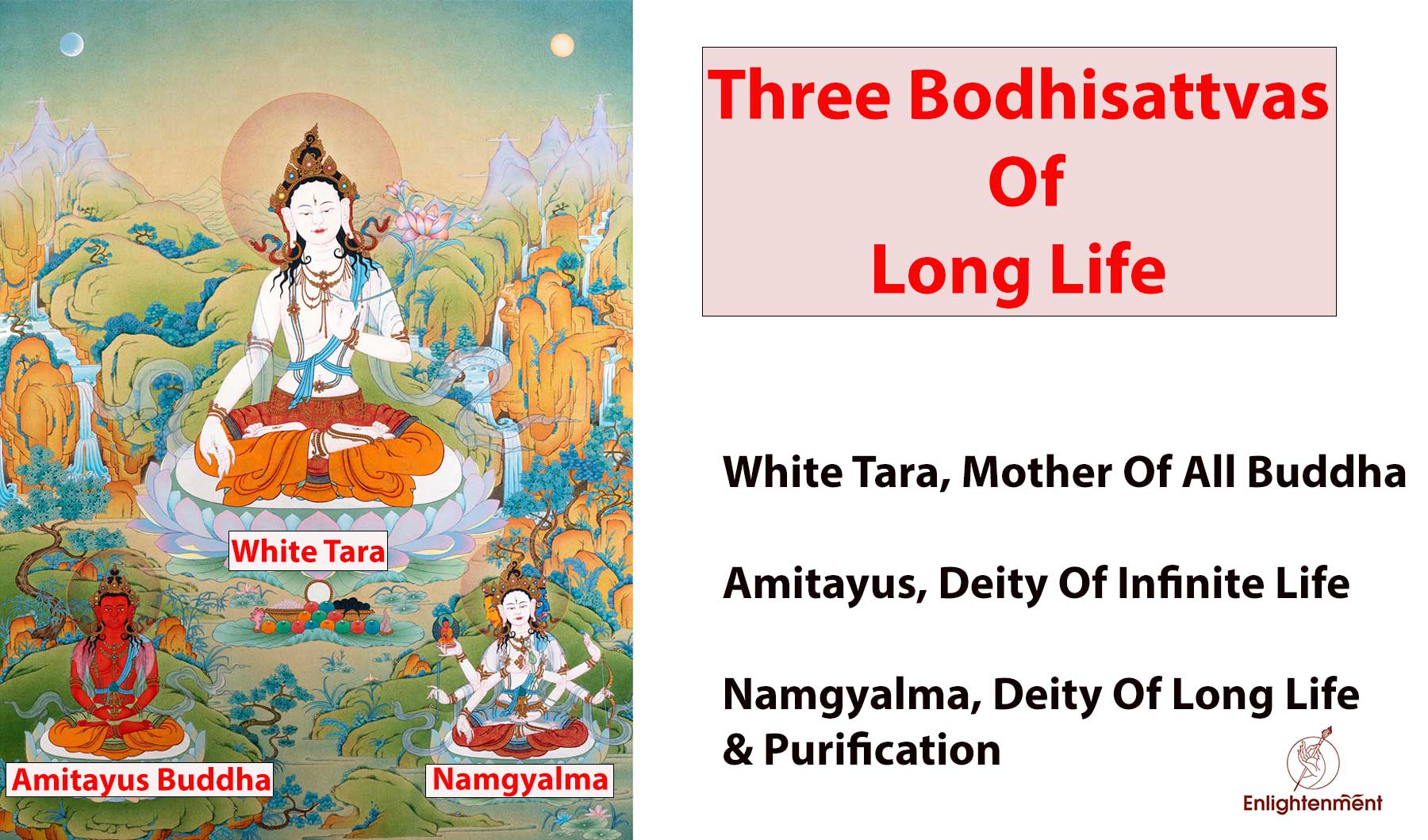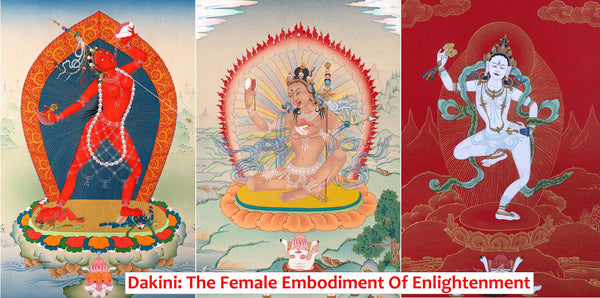Buddhist Deities of Longevity
The human world is the most favorable of the 6 realms of existence. Because of this, practitioners living here have the chance to amass the most merit, which will let them ascend to higher worlds. Tibetan Buddhists perform ceremonies involving the long-life deities to foster long life.
Long virtuous human lives will also aid in avoiding reincarnation into the more challenging lower realms of existence. Therefore, it is most fortunate to acquire merit and good karma in the human realm. Amitayus, White Tara, and Namgyalma are the three long-lived deities. Each deity possesses unique abilities that devotees aspire to use. They are highly revered and practitioners perform rituals and ceremonies chanting their mantra for longevity.
White Tara, Mother Of All Buddhas
Click here to view our High Quality White Tara Thangka Painting
In Sanskrit, White Tara, also known as Sita Tara, is revered as the mother of all Buddhas and represents the maternal side of compassion. Her all-white appearance stands for purity, the flawless truth of the Dharma, and impeccably pure insight. She is also linked to longevity, recovery from physical and mental diseases, and eradicating obstacles that stand in the way of achieving enlightenment. Her ability relates to stopping misfortunes, natural calamities, physical degeneration, and anything else that can jeopardize life.
In Tibet, she is referred to as 'Drolma Karmo' or 'Drolkar'. Together with Amitayus and Ushnishavijaya, she is the primary longevity deity in the pantheon of Tibetan Buddhism. Devotees understand that the unique traits in women are reincarnations of their enlightened essence. This custom is practiced throughout the Tibetan Buddhist regions, including Mongolia.
White Tara is usually depicted in radiant white color with a peaceful and serene facial expression. In the thangka, she is portrayed seated on a moon disc upon a lotus seat, holding a lotus with her right hand. The upper part of her hair was tied in a top knot and wearing a crown on her head that included the 8 ornaments and the 5 silk of a peaceful deity.
The 8-jeweled crown includes a jeweled crown, jewel earrings, a short necklace, two long necklaces-one longer than the other, a bracelet on each wrist, a golden belt at the waist with loops of jewelry, armlets on each arm and an ankle let on each foot. The 5 pieces of silk are composed of a silk ribbon hanging from the back of the head, an upper garment, a long scarf, a silk skirt, and a lower garment.
White Tara Mantra
"OM TARE TUTTARE TURE AMA AYUH-PUNYA JNANA-PUSTIM KURU SVAHA."
Amitayus, The Deity of Infinite Life
Click here to view our Traditional Buddha Amitayus Thangka Painting
The sambhogakaya manifestation of Amitabha Buddha is Amitayus. As an outcome, Amitabha is believed to be the incarnation of Amitayus to aid sentient existence. The Buddha of infinite life and brightness is Amitabha Buddha. Also known as "Infinite Life."
The Dhyana "meditation" mudra is usually depicted on sculptures and Thangka paintings of Amitayus by placing both hands flat on the lap with the palms facing upward. The fastest possible way to gain merit is via meditation. On top of the right hand on his lap, the "vessel of immortality" is also there. The nectar of long life, "amrita," is contained inside the immortality vessel.
The immortality vase is filled with sanctified wine as part of Amitayus' long life rite, which devotees join. Devotees will follow the guru's directions while reciting mantras and using precious long-life medicines.
Mantra of Amitayus
"Om Amarani Jiwantiye Soha"
Namgyalma
Click here to view our Hand Painted Dakini Thangka Painting
Namgyalma is a female yidam and a long-life deity from the Kriya Tantra school in Tibetan Buddhism. In Tibet, Ushnishavijaya is referred to as Namgyalma. She is one of the main long-lived deities in the pantheons of Tibet. Her practice belongs to the Action Tantra school.
All of the major Tibetan Buddhist lineages practice her. Instead of yogic and meditative disciplines, ceremonial invocation is the focus of the practice. She resembles the Buddha Amitayus most closely. Namgyalma offers rebirth in a Buddha heaven and long life. She emerged from Shakyamuni Buddha's crown of bright light/ rays. The flame-ish crown of light (Usnisha) signifies spiritual mastery.
It is the outcome of the Buddha achieving unbounded consciousness, vision, and wisdom. The center of cosmic awareness and inner vision is at the head's top. Beyond the realm of the bodily senses, the divine eye may detect spiritual truths and subtle occurrences.
She is generally pictured as having 8 arms, white in body color seated and holding different symbolic objects in each of her hands. She is holding the twin Dorje, the foundation of the physical cosmos, in front of her chest. This empowering sign banishes evil to improve karma. She also has an Amitabha Buddha statue in her upper right hand. Additionally, she has the immortality vessel in her lap.
One aspect of Namgyalma's long-life practice is the recital of her potent mantra, which promotes both karma purification and long life. Her long-life chant can also guarantee rebirth into the higher realms by being spoken into an animal's ear. Devas and people will not reincarnate into lower realms thanks to Namgyalma's long-life practice.
Namgyalma Long Life Mantra:
“Om Bhrum Soha Om Amrita Ayur Da Dai Soha”
The three long-life deities sculptures or thangka paintings are the focal points of long-life ceremonies and rituals. Guru who oversees the ritual also employs a blend of conventional and superior techniques. As a consequence, practitioners will consume special wine and long-life medicines. Before being employed, these objects are blessed and used in conjunction with mantra recitation and deity contemplation.
Rituals that promote long life are beneficial for preventing the three causes of death. The depletion of merit, the exhaustion of karma, and the exhaustion of life energy are regarded by Buddhists as the three causes of death. A person may pass away if even one of these elements is depleted.
The acquisition of merit by ritual performance can, however, lengthen life. Furthermore, carrying out long-life deity rituals will help the practitioner feel spiritual and mentally whole, which helps ward against disease and promote good health.



3 comments
Therese
Beautifully constructed composed. Thank you for the 3 mantras.
Therese
Beautifully constructed composed. Thank you for the 3 mantras.
Sambu Siongju
Long life